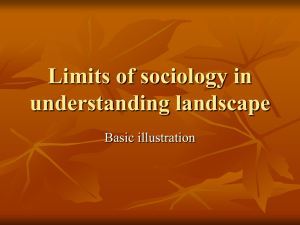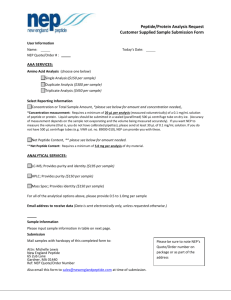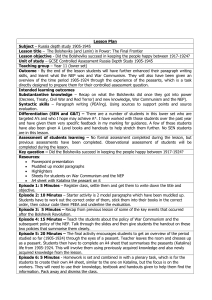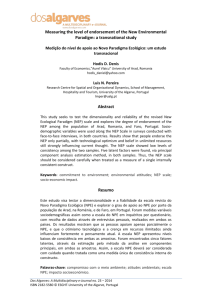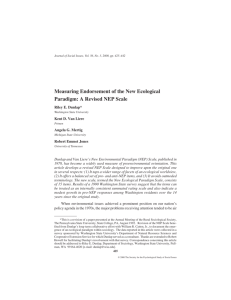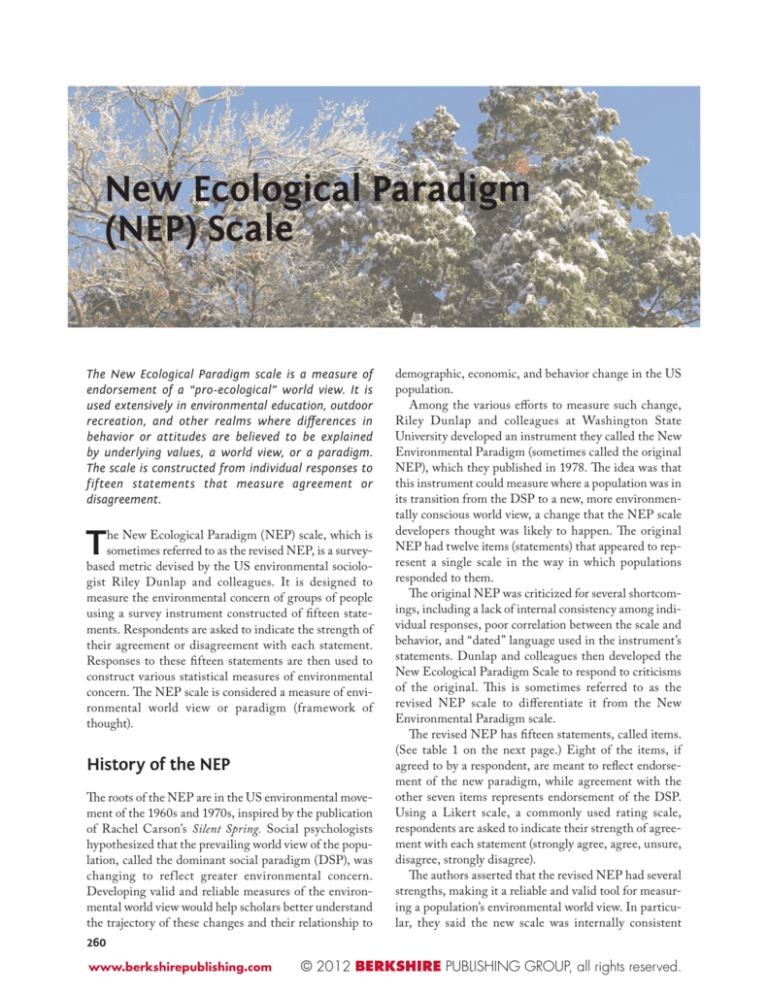
New Ecological Paradigm
(NEP) Scale
The New Ecological Paradigm scale is a measure of
endorsement of a “pro-ecological” world view. It is
used extensively in environmental education, outdoor
recreation, and other realms where differences in
behavior or attitudes are believed to be explained
by underlying values, a world view, or a paradigm.
The scale is constructed from individual responses to
fifteen statements that measure agreement or
disagreement.
T
he New Ecological Paradigm (NEP) scale, which is
sometimes referred to as the revised NEP, is a surveybased metric devised by the US environmental sociologist Riley Dunlap and colleagues. It is designed to
measure the environmental concern of groups of people
using a survey instrument constructed of fi fteen statements. Respondents are asked to indicate the strength of
their agreement or disagreement with each statement.
Responses to these fi fteen statements are then used to
construct various statistical measures of environmental
concern. The NEP scale is considered a measure of environmental world view or paradigm (framework of
thought).
History of the NEP
The roots of the NEP are in the US environmental movement of the 1960s and 1970s, inspired by the publication
of Rachel Carson’s Silent Spring. Social psychologists
hypothesized that the prevailing world view of the population, called the dominant social paradigm (DSP), was
changing to ref lect greater environmental concern.
Developing valid and reliable measures of the environmental world view would help scholars better understand
the trajectory of these changes and their relationship to
demographic, economic, and behavior change in the US
population.
Among the various efforts to measure such change,
Riley Dunlap and colleagues at Washington State
University developed an instrument they called the New
Environmental Paradigm (sometimes called the original
NEP), which they published in 1978. The idea was that
this instrument could measure where a population was in
its transition from the DSP to a new, more environmentally conscious world view, a change that the NEP scale
developers thought was likely to happen. The original
NEP had twelve items (statements) that appeared to represent a single scale in the way in which populations
responded to them.
The original NEP was criticized for several shortcomings, including a lack of internal consistency among individual responses, poor correlation between the scale and
behavior, and “dated” language used in the instrument’s
statements. Dunlap and colleagues then developed the
New Ecological Paradigm Scale to respond to criticisms
of the original. Th is is sometimes referred to as the
revised NEP scale to differentiate it from the New
Environmental Paradigm scale.
The revised NEP has fifteen statements, called items.
(See table 1 on the next page.) Eight of the items, if
agreed to by a respondent, are meant to reflect endorsement of the new paradigm, while agreement with the
other seven items represents endorsement of the DSP.
Using a Likert scale, a commonly used rating scale,
respondents are asked to indicate their strength of agreement with each statement (strongly agree, agree, unsure,
disagree, strongly disagree).
The authors asserted that the revised NEP had several
strengths, making it a reliable and valid tool for measuring a population’s environmental world view. In particular, they said the new scale was internally consistent
260
www.berkshirepublishing.com
© 2012 Berkshire Publishing Group, all rights reserved.
NEW ECOLOGICAL PARADIGM (NEP) SCALE
• 261
Table 1. Revised NEP Statements
1. We are approaching the limit of the number of people the Earth can support.
2. Humans have the right to modify the natural environment to suit their needs.
3. When humans interfere with nature it often produces disastrous consequences.
4. Human ingenuity will insure that we do not make the Earth unlivable.
5. Humans are seriously abusing the environment.
6. The Earth has plenty of natural resources if we just learn how to develop them.
7. Plants and animals have as much right as humans to exist.
8. The balance of nature is strong enough to cope with the impacts of modern industrial nations.
9. Despite our special abilities, humans are still subject to the laws of nature.
10. The so-called “ecological crisis” facing humankind has been greatly exaggerated.
11. The Earth is like a spaceship with very limited room and resources.
12. Humans were meant to rule over the rest of nature.
13. The balance of nature is very delicate and easily upset.
14. Humans will eventually learn enough about how nature works to be able to control it.
15. If things continue on their present course, we will soon experience a major ecological catastrophe.
Source: Dunlap et al. (2000).
The seven even numbered items, if agreed to by a respondent, are meant to represent statements endorsed by the dominant social paradigm
(DSP). The eight odd items, if agreed to by a respondent, are meant to reflect endorsement of the new environmental paradigm (NEP).
(people who responded to some items in one pattern
tended to respond to other items in a consistent manner)
and that it represented a measure of a single scale (that it
had unidimensionality).
Use and Critiques
The revised NEP is used widely in the United States and
in many other nations. It is used in cross-sectional assessments of the relationship of environmental world views
to attitudes on public policy, to recreation participation
patterns, and to pro-environmental behaviors. It is also
used in before-and-after studies of the effects of some
intervention or activity, such as the impact of educational
programs on environmental world views. It is probably
the most widely used measure of environmental values or
attitudes, worldwide.
The revised NEP scale has its critics. There are three
broad categories of criticism. First is the assertion that
the revised NEP scale is missing certain elements of a
pro-ecological world view and thus is incomplete.
Specifically, it is said that the scale leaves out expressions
of a biocentric or ecocentric world view that comes from
late twentieth-century environmental ethics literature.
A second line of criticism concerns the validity of the
scale. Th is comes typically from researchers who have
tried to document links between NEP scale results and
www.berkshirepublishing.com
pro-environmental behavior. When links between NEP
scale results and behavior are weak, some researchers
suggest that the scale fails to measure a world view accurately. Tests of the NEP scale as a predictor of environmental behavior are part of extensive social-psychological
research to explain the root causes of environmental
behavior.
Finally, there is considerable debate about the dimensionality of the revised NEP scale. Dunlap and colleagues argued that the NEP in both of its iterations
measures a single dimension, endorsement of a world
view that could be measured simply by adding up the
responses. Numerous studies have used a statistical technique called principal components analysis to test this.
These studies had different results, suggesting that the
NEP captured not one dimension but often three or more
dimensions. This variability in results leads some to question both the NEP’s validity (does it measure the phenomena it is claiming to measure?) and its reliability
(does it measure those phenomena in the same way across
different populations or across time?).
Future of the NEP Scale
Given its extensive use in many settings, the New
Ecological Paradigm scale will continue to be used
widely. Because no other instrument has been so
© 2012 Berkshire Publishing Group, all rights reserved.
262 • THE BERKSHIRE ENCYCLOPEDIA OF SUSTAINABILITY: MEASUREMENTS, INDICATORS, AND RESEARCH METHODS FOR SUSTAINABILITY
extensively accepted as a measure of environmental world
views, it will continue to be valuable, if for no other reason than it gives researchers comparisons to make across
study types, population types, and time. The growing
body of research will create additional opportunities to
test the NEP for its reliability and validity.
More importantly, it is clear that underlying values
will have significant effects on debates around sustainability. Advocates for the usefulness of the revised NEP
scale believe that progress toward sustainability would be
reflected in shifts in NEP scale scores in the general population from endorsement of the dominant social paradigm toward endorsement of a New Ecological Paradigm.
As such, the revised NEP scale would be a fundamental
metric of progress toward sustainability. In the same
manner, public information or sustainability education
campaigns would be deemed successful if they caused a
similar shift. For the NEP scale to serve this function
effectively, however, there will need to be greater acceptance of its validity and reliability as a metric of sustainability values.
Mark W. ANDERSON
University of Maine, Orono
See also Challenges to Measuring Sustainability; Citizen
Science; Community and Stakeholder Input;
Environmental Justice Indicators; Focus Groups;
Participatory Action Research; Quantitative vs. Qualitative
Studies; Sustainability Science; Transdisciplinary Research;
Weak vs. Strong Sustainability Debate
www.berkshirepublishing.com
FURTHER READING
Dunlap, Riley E. (2008). The new environmental paradigm scale:
From marginality to worldwide use. Journal of Environmental
Education , 40 (1), 3–18.
Dunlap, Riley E.; Van Liere, Kent D.; Mertig, Angela G.; & Jones,
Robert Emmet. (2000). Measuring endorsement of the new ecological paradigm: A revised NEP scale. Journal of Social Issues ,
56(3), 425–442.
Hunter, Lori M., & Rinner, Lesley. (2004). The association between
environmental perspective and knowledge and concern with species diversity. Society and Natural Resources, 17, 517–532.
Kotchen, Matthew, & Reiling, Stephen D. (2000). Environmental
attitudes, motivations, and contingent valuation of nonuse values:
A case study involving endangered species. Ecological Economics ,
31(1), 93–107.
LaLonde, Roxanne, & Jackson, Edgar L. (2002). The new environmental paradigm scale: Has it outlived its usefulness? Journal of
Environmental Education , 33(4), 28–36.
Hawcroft, Lucy J., & Milfont, Taciano L. (2010). The use (and abuse)
of the new environmental paradigm scale over the last 20 years: A
meta-analysis. Journal of Environmental Psychology, 30, 143–158.
Lundmark, Cartina. (2007). The new ecological paradigm revisited:
Anchoring the NEP scale in environmental ethics. Environmental
Education Research, 13(3), 329–347.
Shepard, Kerry; Mann, Samuel; Smith, Nell; & Deaker, Lynley.
(2009). Benchmarking the environmental values and attitudes
of students in New Zealand’s post-compulsory education.
Environmental Education Research, 15(5), 571–587.
Stern, Paul C.; Dietz, Thomas; & Guagnano, Gregory. A. (1995).
The new ecological paradigm in social-psychological context.
Environment and Behavior, 27(6), 723–743.
Teisl, Mario, et al. (2011). Are environmental professors unbalanced?
Evidence from the field. Journal of Environmental Education , 42 (2),
67–83.
Thapa, Brijesh. (2010). The mediation effect of outdoor recreation participation on environmental attitude-behavior correspondence. The
Journal of Environmental Education , 14 (3), 133–150.
© 2012 Berkshire Publishing Group, all rights reserved.





